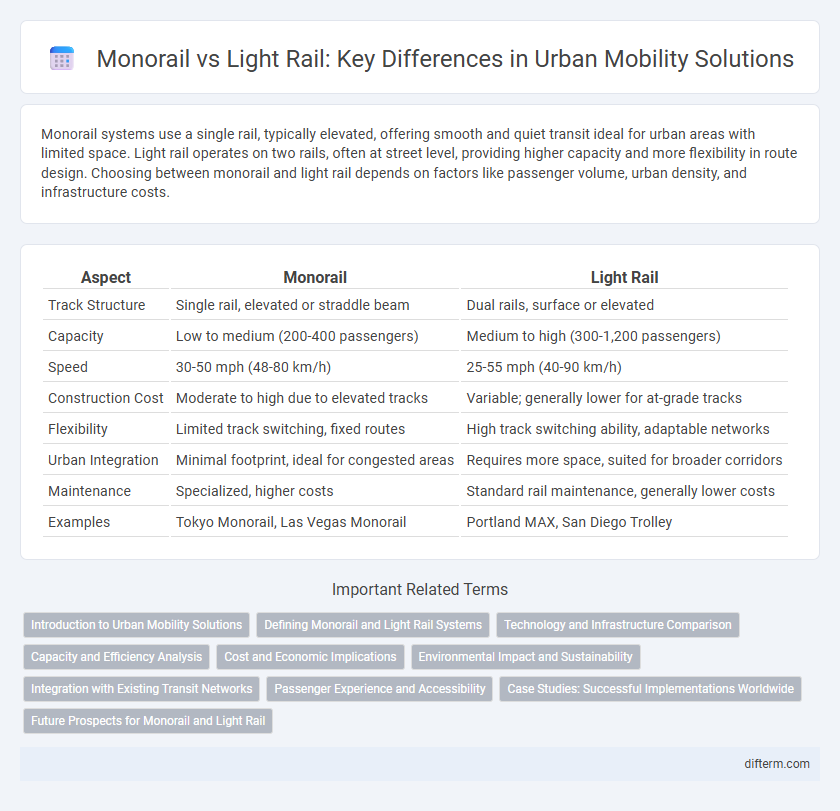Monorail systems use a single rail, typically elevated, offering smooth and quiet transit ideal for urban areas with limited space. Light rail operates on two rails, often at street level, providing higher capacity and more flexibility in route design. Choosing between monorail and light rail depends on factors like passenger volume, urban density, and infrastructure costs.
Table of Comparison
| Aspect | Monorail | Light Rail |
|---|---|---|
| Track Structure | Single rail, elevated or straddle beam | Dual rails, surface or elevated |
| Capacity | Low to medium (200-400 passengers) | Medium to high (300-1,200 passengers) |
| Speed | 30-50 mph (48-80 km/h) | 25-55 mph (40-90 km/h) |
| Construction Cost | Moderate to high due to elevated tracks | Variable; generally lower for at-grade tracks |
| Flexibility | Limited track switching, fixed routes | High track switching ability, adaptable networks |
| Urban Integration | Minimal footprint, ideal for congested areas | Requires more space, suited for broader corridors |
| Maintenance | Specialized, higher costs | Standard rail maintenance, generally lower costs |
| Examples | Tokyo Monorail, Las Vegas Monorail | Portland MAX, San Diego Trolley |
Introduction to Urban Mobility Solutions
Monorail systems offer elevated, space-efficient transit ideal for densely populated urban areas, while light rail provides flexible routes with at-grade tracks that integrate seamlessly into existing city infrastructure. Both urban mobility solutions aim to reduce congestion and lower emissions by promoting public transportation over private vehicle use. Choosing between monorail and light rail depends on city planning priorities, budget constraints, and projected passenger volumes.
Defining Monorail and Light Rail Systems
Monorail systems consist of a single rail, typically elevated, providing streamlined transit with minimal ground footprint, ideal for urban areas seeking space-efficient solutions. Light rail systems operate on double tracks, often at street level or reserved corridors, offering flexible routing and higher passenger capacity through multiple vehicles. Both systems serve urban mobility needs but differ in infrastructure complexity, speed, and integration with existing transit networks.
Technology and Infrastructure Comparison
Monorail systems utilize a single beam track, offering elevated infrastructure that reduces ground-level disruption and requires a narrower right-of-way compared to light rail, which operates on dual tracks often integrated with street-level or dedicated corridors. Light rail technology supports higher passenger capacity and greater operational flexibility with multiple vehicle types and power systems, while monorails typically feature automated, driverless trains powered by electric motors on rubber tires, providing quieter and smoother rides. Infrastructure costs for monorails are generally higher due to specialized guideways and support structures, whereas light rail benefits from more adaptable track construction and easier network expansion.
Capacity and Efficiency Analysis
Monorails typically offer lower passenger capacity compared to light rail systems, which can transport up to 30,000 passengers per hour per direction due to their multi-car configurations and higher frequency operations. Light rail efficiency benefits from dedicated tracks and advanced signaling systems, enabling faster speeds and reduced headways, whereas monorails often face limitations in scalability and interoperability. The superior energy efficiency of light rail, combined with its ability to serve densely populated urban corridors, makes it a more effective choice for high-capacity transit solutions.
Cost and Economic Implications
Monorail systems often present higher initial construction costs due to specialized infrastructure and limited supplier options, whereas light rail benefits from established technology and competitive pricing. Operational expenses for light rail can be lower long-term, supported by greater ridership capacity and energy efficiency, which positively impact farebox recovery ratios and public funding requirements. Economic implications include urban development potential, where light rail tends to stimulate more extensive transit-oriented growth and property value increases compared to monorail alternatives.
Environmental Impact and Sustainability
Monorail systems typically have a smaller environmental footprint due to their elevated structure, reducing land use and habitat disruption compared to light rail, which often requires extensive ground-level tracks and infrastructure. Light rail vehicles usually consume less energy per passenger kilometer and can be powered by renewable electricity sources, enhancing sustainability over fossil-fuel-dependent transport modes. Both systems contribute to reducing urban air pollution and greenhouse gas emissions by offering efficient public transit alternatives that decrease reliance on private cars.
Integration with Existing Transit Networks
Monorail systems typically offer seamless integration with existing transit networks due to their elevated tracks, minimizing interference with surface traffic and enabling easy transfers at major hubs. Light rail networks often require dedicated street-level tracks, which can complicate integration but provide greater accessibility within urban areas. Efficient connectivity between monorails or light rail and other modes like buses and subways enhances overall transit system cohesion and passenger convenience.
Passenger Experience and Accessibility
Monorails offer smooth rides with minimal noise and vibration, enhancing passenger comfort, while light rail systems provide spacious, easily accessible vehicles with multiple doors for faster boarding and alighting. Light rail stations commonly feature level boarding, tactile guidance paths, and elevators, ensuring compliance with ADA standards and better accessibility for passengers with disabilities. The design of light rail often prioritizes easy transfers and integration with other transit modes, improving overall passenger experience compared to the typically isolated monorail lines.
Case Studies: Successful Implementations Worldwide
Case studies demonstrate the efficacy of monorail systems in cities like Tokyo and Sao Paulo, where elevated tracks reduce urban congestion and offer seamless transit integration. Light rail projects in Portland and Melbourne showcase flexible routing and lower infrastructure costs, enhancing accessibility within dense metropolitan areas. These implementations illustrate how transit solutions tailored to specific urban landscapes improve sustainability and commuter experience globally.
Future Prospects for Monorail and Light Rail
Monorail systems offer compact infrastructure with elevated tracks reducing urban congestion, making them suitable for future mobility in densely populated cities. Light rail transit provides flexible routing options and higher passenger capacity, enabling efficient mass transportation as urban areas expand. Investment trends indicate increasing integration of both systems in multimodal networks to optimize sustainable urban mobility solutions.
monorail vs light rail Infographic

 difterm.com
difterm.com